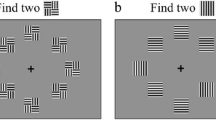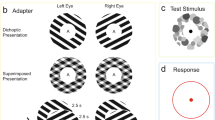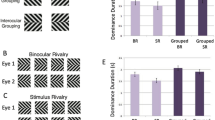Abstract
When the two eyes view very dissimilar images, the visual system often fails to combine the images and one experiences stochastically alternating percepts. This phenomenon, called binocular rivalry, has fascinated researchers for centuries since it provides insights into two critical aspects of visual perception: visual consciousness and cortical suppression. Here, we review the mechanisms of binocular rivalry from a cognitive neuroscience perspective, focusing on empirical findings from two widely used methods—functional magnetic resonance imaging (fMRI) and electroencephalography (EEG). With these techniques, researchers have been able to identify the cortical sites of suppression in binocular rivalry, probe neural responses evoked by unconscious (invisible) visual stimuli, and examine the role of top-down attentional signals in rivalry. We conclude by proposing some future directions for the study of binocular rivalry.



Similar content being viewed by others
References
James W (1890) The consciousness of self. Princ Psychol
Wandell BA (1999) Computational neuroimaging of human visual cortex. Annu Rev Neurosci 22:145–173
Grill-Spector K, Malach R (2004) The human visual cortex. Annu Rev Neurosci 27:649–677
Tong F, Nakayama K, Vaughan JT, Kanwisher N (1998) Binocular rivalry and visual awareness in human extrastriate cortex. Neuron 21:753–759
Lumer ED, Friston KJ, Rees G (1998) Neural correlates of perceptual rivalry in the human brain. Science 280:1930–1934
Lumer ED, Rees G (1999) Covariation of activity in visual and prefrontal cortex associated with subjective visual perception. Proc Natl Acad Sci USA 96:1669–1673
Polonsky A, Blake R, Braun J, Heeger DJ (2000) Neuronal activity in human primary visual cortex correlates with perception during binocular rivalry. Nat Neurosci 3:1153–1159
Cobb WA, Morton HB, Ettlinger G (1967) Cerebral Potentials evoked by pattern reversal and their suppression in visual rivalry. Nature 216:1123–1125
Lansing RW (1964) Electroencephalographic correlates of binocular rivalry in man. Science 146:1325–1327
Brown RJ, Norcia AM (1997) A method for investigating binocular rivalry in real-time with the steady-state VEP. Vision Res 37:2401–2408
Cosmelli D et al (2004) Waves of consciousness: ongoing cortical patterns during binocular rivalry. Neuroimage 23:128–140
Tononi G, Srinivasan R, Russell DP, Edelman GM (1998) Investigating neural correlates of conscious perception by frequency-tagged neuromagnetic responses. Proc Natl Acad Sci USA 95:3198–3203
Tong F (2003) Primary visual cortex and visual awareness. Nat Rev Neurosci 4:219–229
Wunderlich K, Schneider KA, Kastner S (2005) Neural correlates of binocular rivalry in the human lateral geniculate nucleus. Nat Neurosci 8:1595–1602
Haynes JD, Deichmann R, Rees G (2005) Eye-specific effects of binocular rivalry in the human lateral geniculate nucleus. Nature 438:496–499
Frassle S, Sommer J, Jansen A, Naber M, Einhauser W (2014) Binocular rivalry: frontal activity relates to introspection and action but not to perception. J Neurosci 34:1738–1747
Knapen T, Brascamp J, Pearson J, van Ee R, Blake R (2011) The role of frontal and parietal brain areas in bistable perception. J Neurosci 31:10293–10301
Safavi S, Kapoor V, Logothetis NK, Panagiotaropoulos TI (2014) Is the frontal lobe involved in conscious perception? Front Psychol 5:1063
Weilnhammer VA, Ludwig K, Hesselmann G, Sterzer P (2013) Frontoparietal cortex mediates perceptual transitions in bistable perception. J Neurosci 33:16009–16015
Zaretskaya N, Narinyan M (2014) Introspection, attention or awareness? The role of the frontal lobe in binocular rivalry. Front Hum Neurosci 8:527
Brascamp J, Blake R, Knapen T (2015) Negligible fronto-parietal BOLD activity accompanying unreportable switches in bistable perception. Nat Neurosci 18:1672–1678
Lee SH, Blake R (1999) Rival ideas about binocular rivalry. Vision Res 39:1447–1454
Tong F (2001) Competing theories of binocular rivalry: a possible resolution. Brain Mind 2(1):55–83
Blake R (2001) A primer on binocular rivalry, including current controversies. Brain Mind 2(1):5–38
Kovacs I, Papathomas TV, Yang M, Feher A (1996) When the brain changes its mind: interocular grouping during binocular rivalry. Proc Natl Acad Sci USA 93:15508–15511
Carlson TA, He S (2004) Competing global representations fail to initiate binocular rivalry. Neuron 43:907–914
Tong F, Engel SA (2001) Interocular rivalry revealed in the human cortical blind-spot representation. Nature 411:195–199
Tong F, Meng M, Blake R (2006) Neural bases of binocular rivalry. Trends Cogn Sci 10:502–511
Tsuchiya N, Koch C (2005) Continuous flash suppression reduces negative afterimages. Nat Neurosci 8:1096–1101
Pasley BN, Mayes LC, Schultz RT (2004) Subcortical discrimination of unperceived objects during binocular rivalry. Neuron 42:163–172
Pearson J, Clifford CW (2005) Suppressed patterns alter vision during binocular rivalry. Curr Biol 15:2142–2148
He S, Cavanagh P, Intriligator J (1996) Attentional resolution and the locus of visual awareness. Nature 383:334–337
He S, MacLeod DI (2001) Orientation-selective adaptation and tilt after-effect from invisible patterns. Nature 411:473–476
Blake R, Fox R (1974) Adaptation to invisible gratings and the site of binocular rivalry suppression. Nature 249:488–490
White KD, Petry HM, Riggs LA, Miller J (1978) Binocular interactions during establishment of McCollough effects. Vis Res 18:1201–1215
Blake R, Tadin D, Sobel KV, Raissian TA, Chong SC (2006) Strength of early visual adaptation depends on visual awareness. Proc Natl Acad Sci U S A. 103:4783–4788
Harris JJ, Schwarzkopf DS, Song C, Bahrami B, Rees G (2011) Contextual illusions reveal the limit of unconscious visual processing. Psychol Sci 22:399–405
Sweeny TD, Grabowecky M, Suzuki S (2011) Awareness becomes necessary between adaptive pattern coding of open and closed curvatures. Psychol Sci 22:943–950
Stein T, Sterzer P (2011) High-level face shape adaptation depends on visual awareness: evidence from continuous flash suppression. J Vis 11:5
Moradi F, Koch C, Shimojo S (2005) Face adaptation depends on seeing the face. Neuron 45:169–175
Axelrod V, Bar M, Rees G (2015) Exploring the unconscious using faces. Trends Cogn Sci. 19:35–45
Haynes JD, Rees G (2005) Predicting the orientation of invisible stimuli from activity in human primary visual cortex. Nat Neurosci 8:686–691
Kamitani Y, Tong F (2005) Decoding the visual and subjective contents of the human brain. Nat Neurosci 8:679–685
Jiang Y, He S (2006) Cortical responses to invisible faces: dissociating subsystems for facial-information processing. Curr Biol 16:2023–2029
Williams MA, Morris AP, McGlone F, Abbott DF, Mattingley JB (2004) Amygdala responses to fearful and happy facial expressions under conditions of binocular suppression. J Neurosci 24:2898–2904
Yang E, Zald DH, Blake R (2007) Fearful expressions gain preferential access to awareness during continuous flash suppression. Emotion 7:882–886
Costello P, Jiang Y, Baartman B, McGlennen K, He S (2009) Semantic and subword priming during binocular suppression. Conscious Cogn 18:375–382
Fang F, He S (2005) Cortical responses to invisible objects in the human dorsal and ventral pathways. Nat Neurosci 8:1380–1385
Mueller TJ, Blake R (1989) A fresh look at the temporal dynamics of binocular-rivalry. Biol Cybern 61:223–232
Fukuda H, Blake R (1992) Spatial interactions in binocular rivalry. J Exp Psychol Hum Percept Perform 18:362–370
Paffen CL, Alais D, Verstraten FA (2005) Center-surround inhibition deepens binocular rivalry suppression. Vision Res 45:2642–2649
Paffen CL, Tadin D, te Pas SF, Blake R, Verstraten FA (2006) Adaptive center-surround interactions in human vision revealed during binocular rivalry. Vision Res 46:599–604
Alais D, Blake R (1999) Grouping visual features during binocular rivalry. Vision Res 39:4341–4353
Sobel KV, Blake R (2002) How context influences predominance during binocular rivalry. Perception. 31:813–824
Yu K, Blake R (1992) Do recognizable figures enjoy an advantage in binocular rivalry? J Exp Psychol 18(4):1158
Lee SH, Blake R, Heeger DJ (2005) Traveling waves of activity in primary visual cortex during binocular rivalry. Nat Neurosci 8:22–23
Kersten D, Mamassian P, Yuille A (2004) Object perception as Bayesian inference. Annu Rev Psychol 55:271–304
Yuille A, Kersten D (2006) Vision as Bayesian inference: analysis by synthesis? Trends Cogn Sci 10(7):301–308
Sasaki Y, Nanez JE, Watanabe T (2010) Advances in visual perceptual learning and plasticity. Nat Rev Neurosci 11:53–60
Watanabe T, Sasaki Y (2015) Perceptual learning: toward a comprehensive theory. Annu Rev Psychol 66:197–221
Xu JP, He ZJ, Ooi TL (2010) Effectively reducing sensory eye dominance with a push-pull perceptual learning protocol. Curr Biol 20:1864–1868
Dieter KC, Melnick MD, Tadin D (2016) Perceptual training profoundly alters binocular rivalry through both sensory and attentional enhancements. Proc Natl Acad Sci USA 113(45):12874–12879
Chun MM, Golomb JD, Turk-Browne NB (2011) A taxonomy of external and internal attention. Annu Rev Psychol 62:73–101
Kastner S, Ungerleider LG (2000) Mechanisms of visual attention in the human cortex. Annu Rev Neurosci 23:315–341
Lee SH, Blake R, Heeger DJ (2007) Hierarchy of cortical responses underlying binocular rivalry. Nat Neurosci 10:1048–1054
Zhang P, Jamison K, Engel S, He B, He S (2011) Binocular rivalry requires visual attention. Neuron 71:362–369
Xu H et al (2016) Rivalry-like neural activity in primary visual cortex in anesthetized monkeys. J Neurosci 36:3231–3242
Wilson HR (2003) Computational evidence for a rivalry hierarchy in vision. Proc Natl Acad Sci USA 100:14499–14503
Said CP, Heeger DJ (2013) A model of binocular rivalry and cross-orientation suppression. PLoS Comput Biol 9:e1002991
Dayan P (1998) A hierarchical model of binocular rivalry. Neural Comput 10:1119–1135
Laing CR, Chow CC (2002) A spiking neuron model for binocular rivalry. J Comput Neurosci 12:39–53
Stollenwerk L, Bode M (2003) Lateral neural model of binocular rivalry. Neural Comput 15:2863–2882
Li HH, Carrasco M, Heeger DJ (2015) Deconstructing interocular suppression: attention and divisive normalization. PLoS Comput Biol 11:e1004510
Bartos M, Vida I, Jonas P (2007) Synaptic mechanisms of synchronized gamma oscillations in inhibitory interneuron networks. Nat Rev Neurosci 8:45–56
Vogels TP, Rajan K, Abbott LF (2005) Neural network dynamics. Annu Rev Neurosci 28:357–376
Katyal S, Engel SA, He B, He S (2016) Neurons that detect interocular conflict during binocular rivalry revealed with EEG. J Vis. 16:18
Gershman SJ, Vul E, Tenenbaum JB (2012) Multistability and perceptual inference. Neural Comput 24:1–24
Haefner RM, Berkes P, Fiser J (2016) Perceptual decision-making as probabilistic inference by neural sampling. Neuron 90:649–660
Hohwy J, Roepstorff A, Friston K (2008) Predictive coding explains binocular rivalry: an epistemological review. Cognition 108:687–701
Leopold DA, Logothetis NK (1996) Activity changes in early visual cortex reflect monkeys’ percepts during binocular rivalry. Nature 379:549–553
Lehky SR, Maunsell JHR (1996) No binocular rivalry in the LGN of alert macaque monkeys. Vision Res 36:1225–1234
Whitney D, Levi DM (2011) Visual crowding: a fundamental limit on conscious perception and object recognition. Trends Cogn Sci. 15:160–168
Breitmeyer BG, Ogmen H (2000) Recent models and findings in visual backward masking: a comparison, review, and update. Percept Psychophys 62:1572–1595
Baker DH, Graf EW (2009) On the relation between dichoptic masking and binocular rivalry. Vis Res 49:451–459
Robertson CE, Kravitz DJ, Freyberg J, Baron-Cohen S, Baker CI (2013) Slower rate of binocular rivalry in autism. J Neurosci 33:16983–16991
Casanova JAA, Campos JAA, Sanchez MM, Super H (2013) Onset time of binocular rivalry and duration of inter-dominance periods as psychophysical markers of ADHD. Perception 42:16–27
Miller SM et al (2003) Slow binocular rivalry in bipolar disorder. Psychol Med 33:683–692
Dieter KC, Tadin D (2011) Understanding attentional modulation of binocular rivalry: a framework based on biased competition. Front Hum Neurosci 5:155
Author information
Authors and Affiliations
Corresponding author
Rights and permissions
About this article
Cite this article
Zhang, R., Engel, S.A. & Kay, K. Binocular Rivalry: A Window into Cortical Competition and Suppression. J Indian Inst Sci 97, 477–485 (2017). https://doi.org/10.1007/s41745-017-0048-y
Received:
Accepted:
Published:
Issue Date:
DOI: https://doi.org/10.1007/s41745-017-0048-y




